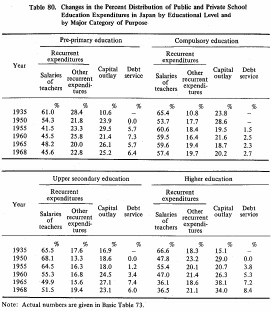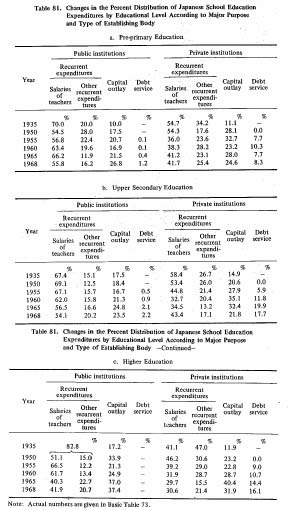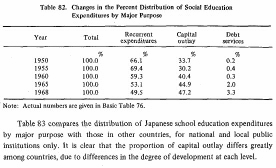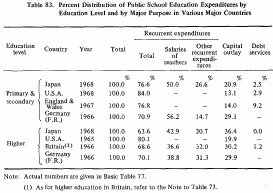| Home > Policy > White Paper, Notice, Announcement > White Paper > EDUCATIONAL STANDARDS IN JAPAN 1971 > CHAPTER |
||
In this section, school and social education expenditures in Japan will be analyzed according to purpose of expenditure. Table 80 shows .the distribution of school education expenditures by major category of purpose and by educational level.
The percent of capital outlay for compulsory education first increased around1950 due to the creation of the new system of lower secondary schools, and again around 1960 to accommodate children born in the so-called "baby boom" years immediately after the War. In recent years, however, the ratio of recurrent expenditures to capital outlay has remained approximately in the ratio of 80 to 20.
Expenditures for teachers' salaries which constitute a large part of the recurrent 'expenditures, make up 60% of the total expenses in compulsory8dL1C3tlO] 1 Wh1l8 the other recurrent expenditures constitute less than 20%. At the other educational levels, the percents for recurrent expenditures are rather low, compared to those in compulsory education, (around 70% in pre-primary and upper secondary and less than 60%in higher education) while the proportions for capital outlay and debt service have recently become higher than those in compulsory education.

Note: Actual numbers are given in Basic Table 73. Basic Table 73
Table 81 shows the distribution by type or establishing body of the figures already shown in Table 80.

Note: Actual numbers are given in Basic Table 76. Basic Table 76
The percents of capital outlay and debt services for pre-primary education have been continuously high throughout the post-war period, especially in private institutions; in public institutions as well, these have recently become rather high. With regard to upper secondary education, the increase of capital outlay caused by the expansion of private upper secondary schools after the war, as well as the accompanying increase of debt services, is noteworthy especially in private schools from 1960 to 1965. In public schools, too, capital outlays increased during the period of rapid enrollment expansion starting in 1962, caused by the entrance of the so-called "baby boom" children.
Finally in higher education, a rise in the percent of capital outlay began around1960, in both national and private institutions while, the rise in the percent for debt services is conspicuous in private institutions due to the accumulation of debts incurred by such institutions.
Turning to social education expenditures. Table 82 shows the percent distribution of expenditures by major purpose. In social education, the proportion of capital outlay is large and has been increasing in recent years because of the rapid increase in expenditures for sports facilities.

Note: Actual numbers are given in Basic Table 76 Basic Table 76
Table 83 compares the distribution of Japanese school education expenditures by major purpose with those in other countries, for national and local public institutions only. It is clear that the proportion of capital outlay differs greatly among countries, due to differences in the degree of development at each level.

Note: Actual numbers are given in Basic Table 77 Basic Table 77
| Back to Top | MEXT HOME |